Analyzing the Global Business Environment for International Success
VerifiedAdded on 2023/06/11
|6
|1104
|426
Report
AI Summary
This report provides an environmental analysis of global and international businesses, emphasizing the importance of international trade and the challenges and opportunities faced by international managers. It examines the impact of globalization and technological advancements on cross-border business activities. The report identifies key factors such as economic, legal, political, socio-cultural, demographic, geographical, and technological aspects that influence the global business environment. It also explores how managers and CEOs of global companies apply environmental analysis to achieve success in cross-border ventures, highlighting the need for understanding the business environment of international countries and creating awareness about the requirements for multinational activity and foreign trading. The conclusion underscores the significance of environmental analysis in helping global companies navigate the complexities of international markets and achieve sustainable growth.

INSTITUTIONAL AFFILIATION(S)
Paraphrase This Document
Need a fresh take? Get an instant paraphrase of this document with our AI Paraphraser
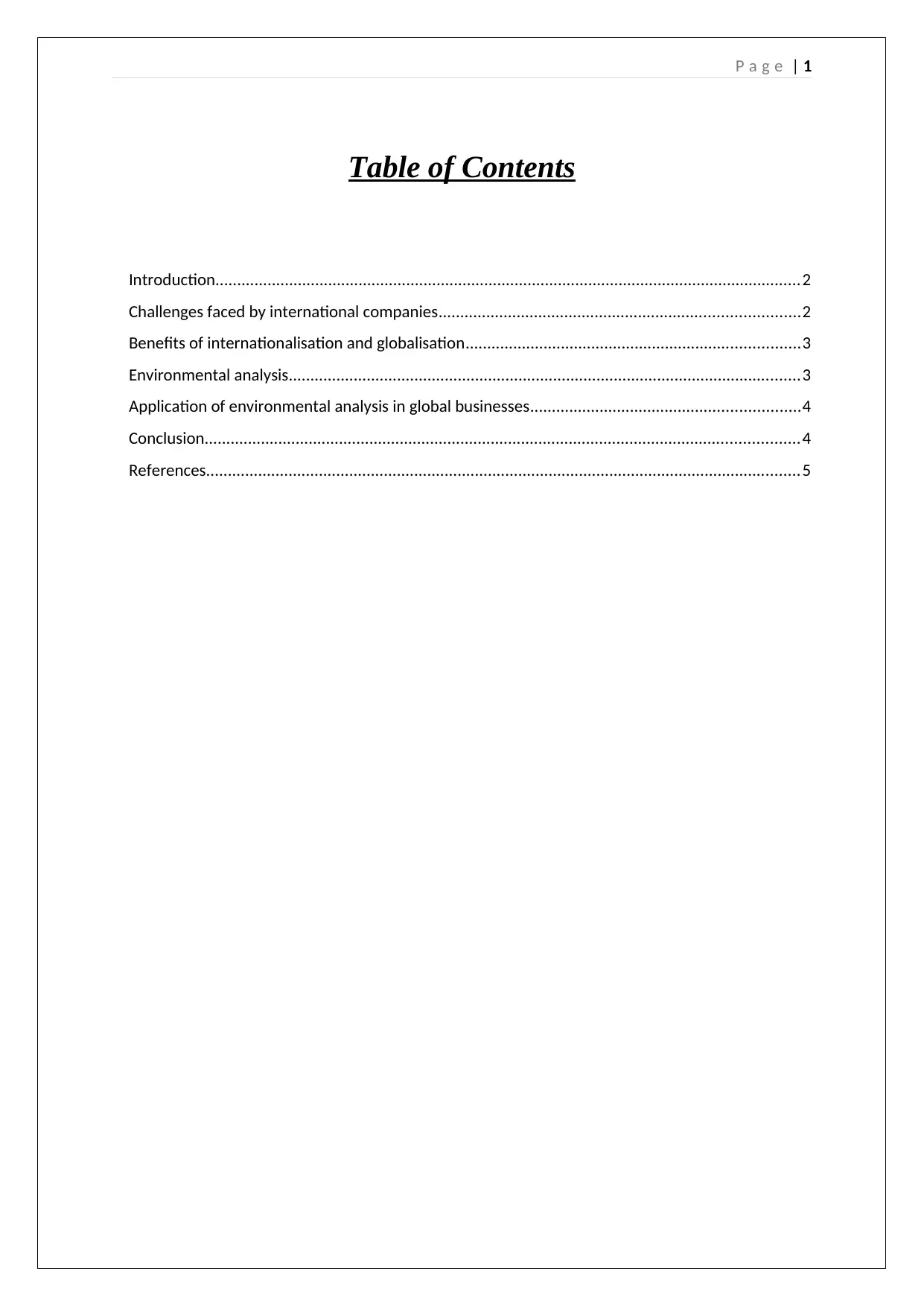
P a g e | 1
Table of Contents
Introduction.......................................................................................................................................2
Challenges faced by international companies...................................................................................2
Benefits of internationalisation and globalisation.............................................................................3
Environmental analysis......................................................................................................................3
Application of environmental analysis in global businesses..............................................................4
Conclusion.........................................................................................................................................4
References.........................................................................................................................................5
Table of Contents
Introduction.......................................................................................................................................2
Challenges faced by international companies...................................................................................2
Benefits of internationalisation and globalisation.............................................................................3
Environmental analysis......................................................................................................................3
Application of environmental analysis in global businesses..............................................................4
Conclusion.........................................................................................................................................4
References.........................................................................................................................................5
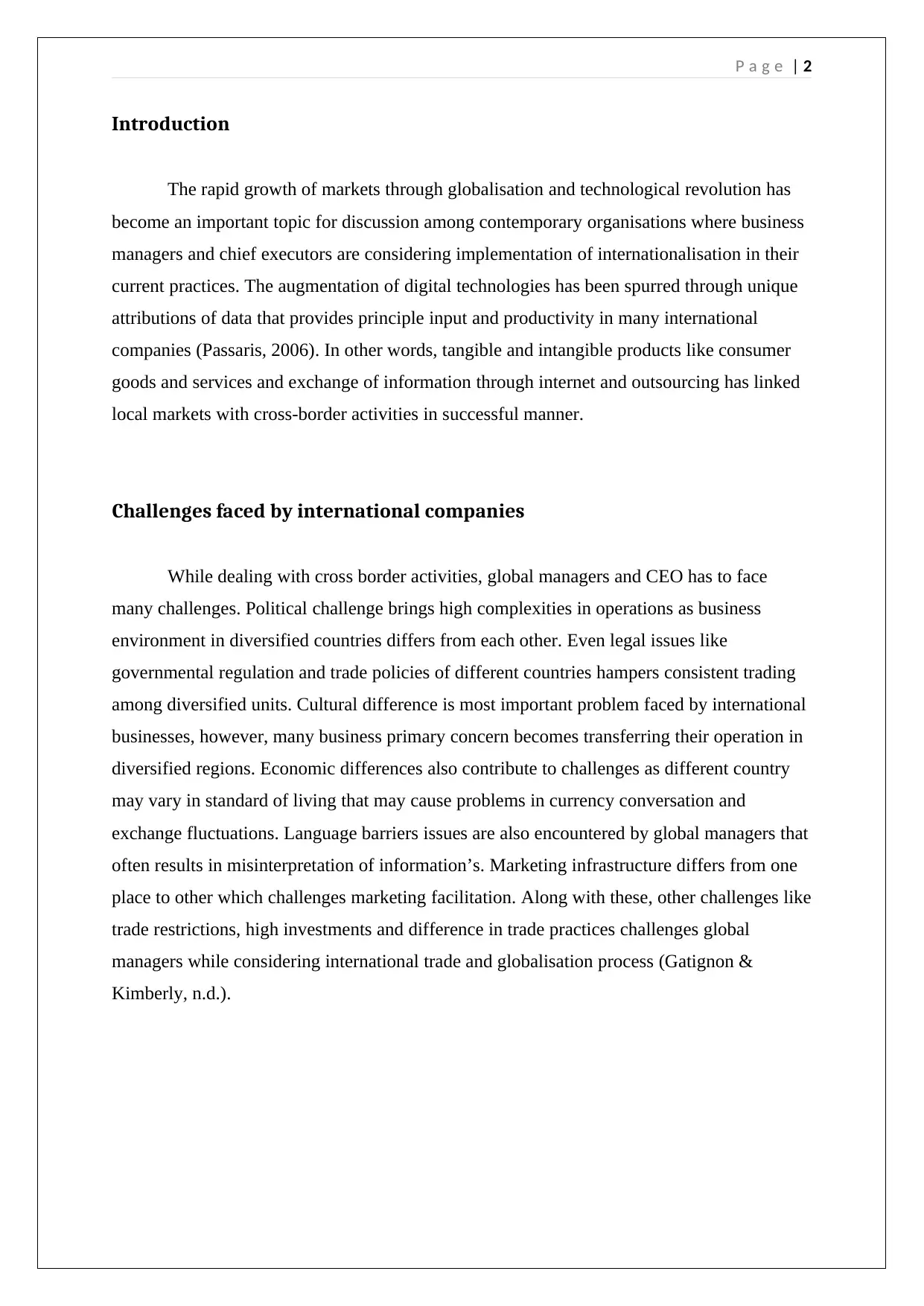
P a g e | 2
Introduction
The rapid growth of markets through globalisation and technological revolution has
become an important topic for discussion among contemporary organisations where business
managers and chief executors are considering implementation of internationalisation in their
current practices. The augmentation of digital technologies has been spurred through unique
attributions of data that provides principle input and productivity in many international
companies (Passaris, 2006). In other words, tangible and intangible products like consumer
goods and services and exchange of information through internet and outsourcing has linked
local markets with cross-border activities in successful manner.
Challenges faced by international companies
While dealing with cross border activities, global managers and CEO has to face
many challenges. Political challenge brings high complexities in operations as business
environment in diversified countries differs from each other. Even legal issues like
governmental regulation and trade policies of different countries hampers consistent trading
among diversified units. Cultural difference is most important problem faced by international
businesses, however, many business primary concern becomes transferring their operation in
diversified regions. Economic differences also contribute to challenges as different country
may vary in standard of living that may cause problems in currency conversation and
exchange fluctuations. Language barriers issues are also encountered by global managers that
often results in misinterpretation of information’s. Marketing infrastructure differs from one
place to other which challenges marketing facilitation. Along with these, other challenges like
trade restrictions, high investments and difference in trade practices challenges global
managers while considering international trade and globalisation process (Gatignon &
Kimberly, n.d.).
Introduction
The rapid growth of markets through globalisation and technological revolution has
become an important topic for discussion among contemporary organisations where business
managers and chief executors are considering implementation of internationalisation in their
current practices. The augmentation of digital technologies has been spurred through unique
attributions of data that provides principle input and productivity in many international
companies (Passaris, 2006). In other words, tangible and intangible products like consumer
goods and services and exchange of information through internet and outsourcing has linked
local markets with cross-border activities in successful manner.
Challenges faced by international companies
While dealing with cross border activities, global managers and CEO has to face
many challenges. Political challenge brings high complexities in operations as business
environment in diversified countries differs from each other. Even legal issues like
governmental regulation and trade policies of different countries hampers consistent trading
among diversified units. Cultural difference is most important problem faced by international
businesses, however, many business primary concern becomes transferring their operation in
diversified regions. Economic differences also contribute to challenges as different country
may vary in standard of living that may cause problems in currency conversation and
exchange fluctuations. Language barriers issues are also encountered by global managers that
often results in misinterpretation of information’s. Marketing infrastructure differs from one
place to other which challenges marketing facilitation. Along with these, other challenges like
trade restrictions, high investments and difference in trade practices challenges global
managers while considering international trade and globalisation process (Gatignon &
Kimberly, n.d.).
⊘ This is a preview!⊘
Do you want full access?
Subscribe today to unlock all pages.

Trusted by 1+ million students worldwide
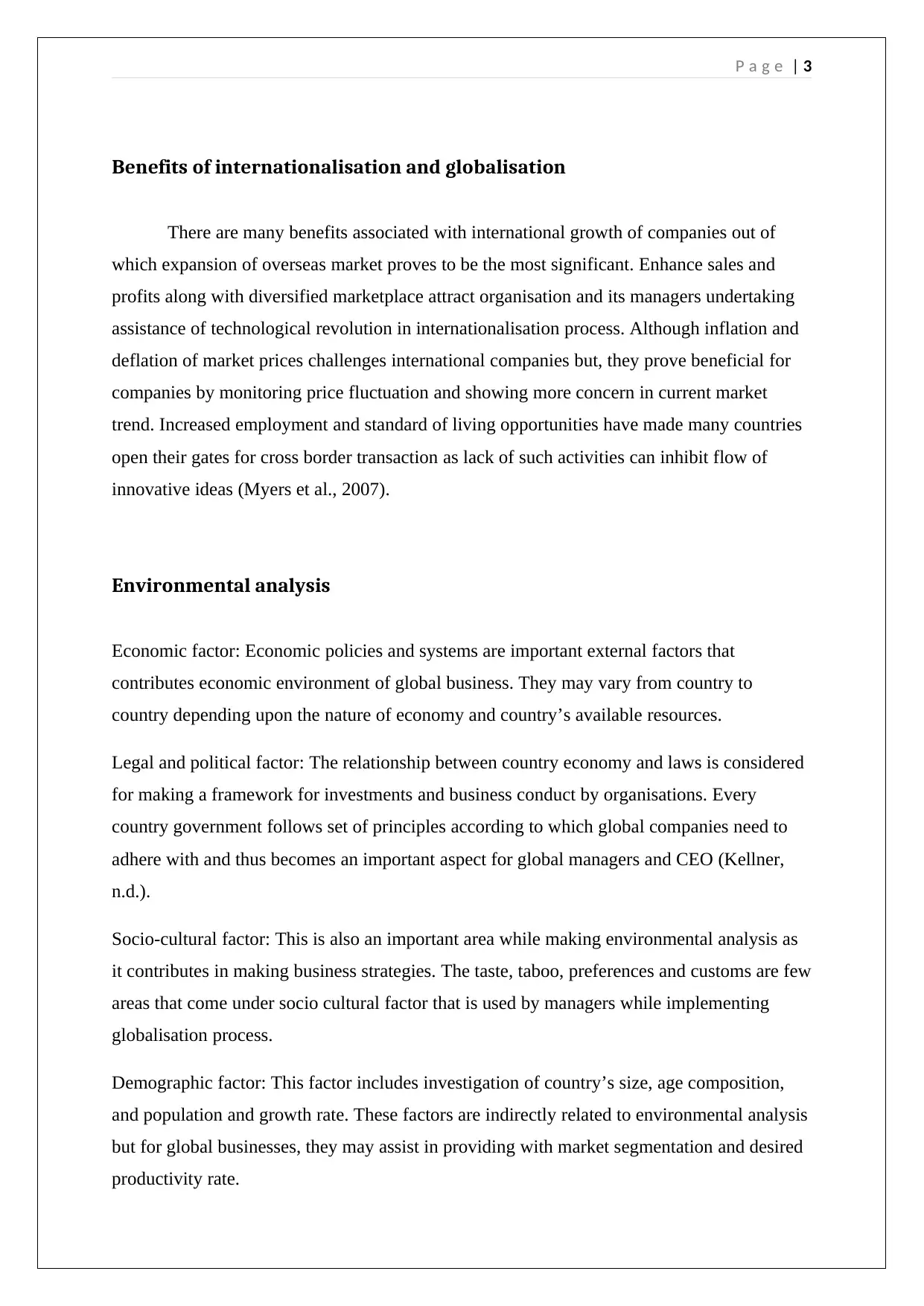
P a g e | 3
Benefits of internationalisation and globalisation
There are many benefits associated with international growth of companies out of
which expansion of overseas market proves to be the most significant. Enhance sales and
profits along with diversified marketplace attract organisation and its managers undertaking
assistance of technological revolution in internationalisation process. Although inflation and
deflation of market prices challenges international companies but, they prove beneficial for
companies by monitoring price fluctuation and showing more concern in current market
trend. Increased employment and standard of living opportunities have made many countries
open their gates for cross border transaction as lack of such activities can inhibit flow of
innovative ideas (Myers et al., 2007).
Environmental analysis
Economic factor: Economic policies and systems are important external factors that
contributes economic environment of global business. They may vary from country to
country depending upon the nature of economy and country’s available resources.
Legal and political factor: The relationship between country economy and laws is considered
for making a framework for investments and business conduct by organisations. Every
country government follows set of principles according to which global companies need to
adhere with and thus becomes an important aspect for global managers and CEO (Kellner,
n.d.).
Socio-cultural factor: This is also an important area while making environmental analysis as
it contributes in making business strategies. The taste, taboo, preferences and customs are few
areas that come under socio cultural factor that is used by managers while implementing
globalisation process.
Demographic factor: This factor includes investigation of country’s size, age composition,
and population and growth rate. These factors are indirectly related to environmental analysis
but for global businesses, they may assist in providing with market segmentation and desired
productivity rate.
Benefits of internationalisation and globalisation
There are many benefits associated with international growth of companies out of
which expansion of overseas market proves to be the most significant. Enhance sales and
profits along with diversified marketplace attract organisation and its managers undertaking
assistance of technological revolution in internationalisation process. Although inflation and
deflation of market prices challenges international companies but, they prove beneficial for
companies by monitoring price fluctuation and showing more concern in current market
trend. Increased employment and standard of living opportunities have made many countries
open their gates for cross border transaction as lack of such activities can inhibit flow of
innovative ideas (Myers et al., 2007).
Environmental analysis
Economic factor: Economic policies and systems are important external factors that
contributes economic environment of global business. They may vary from country to
country depending upon the nature of economy and country’s available resources.
Legal and political factor: The relationship between country economy and laws is considered
for making a framework for investments and business conduct by organisations. Every
country government follows set of principles according to which global companies need to
adhere with and thus becomes an important aspect for global managers and CEO (Kellner,
n.d.).
Socio-cultural factor: This is also an important area while making environmental analysis as
it contributes in making business strategies. The taste, taboo, preferences and customs are few
areas that come under socio cultural factor that is used by managers while implementing
globalisation process.
Demographic factor: This factor includes investigation of country’s size, age composition,
and population and growth rate. These factors are indirectly related to environmental analysis
but for global businesses, they may assist in providing with market segmentation and desired
productivity rate.
Paraphrase This Document
Need a fresh take? Get an instant paraphrase of this document with our AI Paraphraser
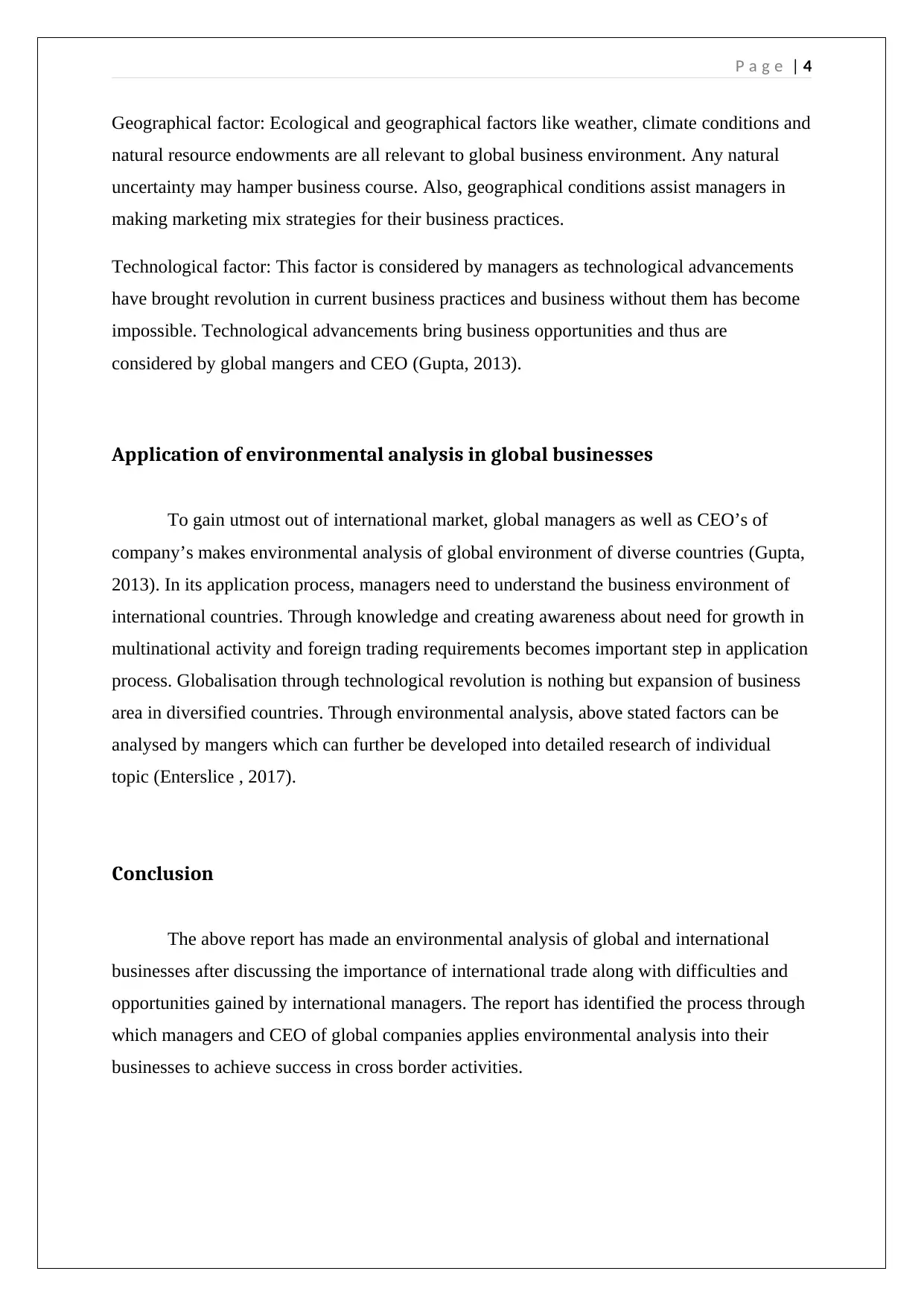
P a g e | 4
Geographical factor: Ecological and geographical factors like weather, climate conditions and
natural resource endowments are all relevant to global business environment. Any natural
uncertainty may hamper business course. Also, geographical conditions assist managers in
making marketing mix strategies for their business practices.
Technological factor: This factor is considered by managers as technological advancements
have brought revolution in current business practices and business without them has become
impossible. Technological advancements bring business opportunities and thus are
considered by global mangers and CEO (Gupta, 2013).
Application of environmental analysis in global businesses
To gain utmost out of international market, global managers as well as CEO’s of
company’s makes environmental analysis of global environment of diverse countries (Gupta,
2013). In its application process, managers need to understand the business environment of
international countries. Through knowledge and creating awareness about need for growth in
multinational activity and foreign trading requirements becomes important step in application
process. Globalisation through technological revolution is nothing but expansion of business
area in diversified countries. Through environmental analysis, above stated factors can be
analysed by mangers which can further be developed into detailed research of individual
topic (Enterslice , 2017).
Conclusion
The above report has made an environmental analysis of global and international
businesses after discussing the importance of international trade along with difficulties and
opportunities gained by international managers. The report has identified the process through
which managers and CEO of global companies applies environmental analysis into their
businesses to achieve success in cross border activities.
Geographical factor: Ecological and geographical factors like weather, climate conditions and
natural resource endowments are all relevant to global business environment. Any natural
uncertainty may hamper business course. Also, geographical conditions assist managers in
making marketing mix strategies for their business practices.
Technological factor: This factor is considered by managers as technological advancements
have brought revolution in current business practices and business without them has become
impossible. Technological advancements bring business opportunities and thus are
considered by global mangers and CEO (Gupta, 2013).
Application of environmental analysis in global businesses
To gain utmost out of international market, global managers as well as CEO’s of
company’s makes environmental analysis of global environment of diverse countries (Gupta,
2013). In its application process, managers need to understand the business environment of
international countries. Through knowledge and creating awareness about need for growth in
multinational activity and foreign trading requirements becomes important step in application
process. Globalisation through technological revolution is nothing but expansion of business
area in diversified countries. Through environmental analysis, above stated factors can be
analysed by mangers which can further be developed into detailed research of individual
topic (Enterslice , 2017).
Conclusion
The above report has made an environmental analysis of global and international
businesses after discussing the importance of international trade along with difficulties and
opportunities gained by international managers. The report has identified the process through
which managers and CEO of global companies applies environmental analysis into their
businesses to achieve success in cross border activities.
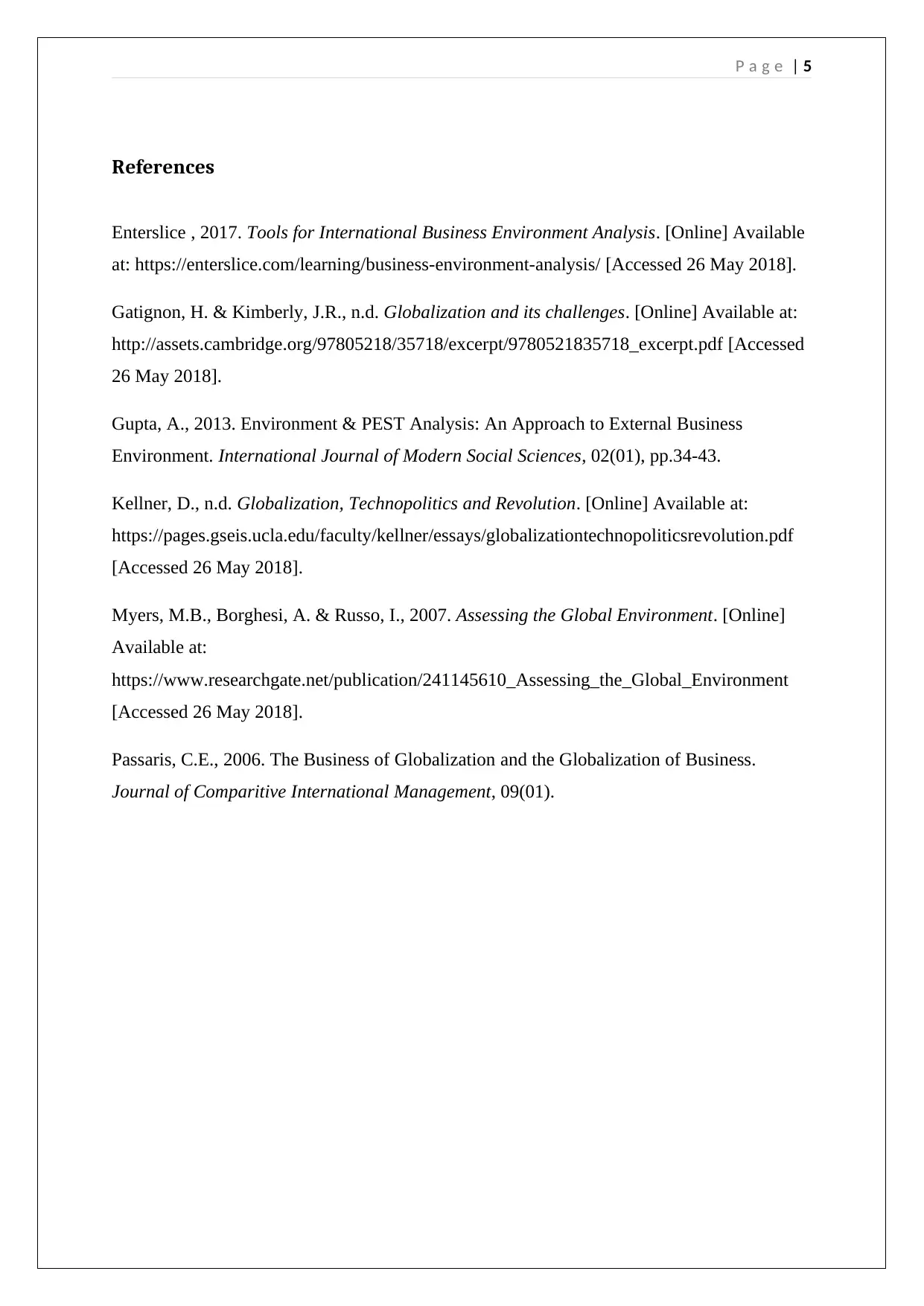
P a g e | 5
References
Enterslice , 2017. Tools for International Business Environment Analysis. [Online] Available
at: https://enterslice.com/learning/business-environment-analysis/ [Accessed 26 May 2018].
Gatignon, H. & Kimberly, J.R., n.d. Globalization and its challenges. [Online] Available at:
http://assets.cambridge.org/97805218/35718/excerpt/9780521835718_excerpt.pdf [Accessed
26 May 2018].
Gupta, A., 2013. Environment & PEST Analysis: An Approach to External Business
Environment. International Journal of Modern Social Sciences, 02(01), pp.34-43.
Kellner, D., n.d. Globalization, Technopolitics and Revolution. [Online] Available at:
https://pages.gseis.ucla.edu/faculty/kellner/essays/globalizationtechnopoliticsrevolution.pdf
[Accessed 26 May 2018].
Myers, M.B., Borghesi, A. & Russo, I., 2007. Assessing the Global Environment. [Online]
Available at:
https://www.researchgate.net/publication/241145610_Assessing_the_Global_Environment
[Accessed 26 May 2018].
Passaris, C.E., 2006. The Business of Globalization and the Globalization of Business.
Journal of Comparitive International Management, 09(01).
References
Enterslice , 2017. Tools for International Business Environment Analysis. [Online] Available
at: https://enterslice.com/learning/business-environment-analysis/ [Accessed 26 May 2018].
Gatignon, H. & Kimberly, J.R., n.d. Globalization and its challenges. [Online] Available at:
http://assets.cambridge.org/97805218/35718/excerpt/9780521835718_excerpt.pdf [Accessed
26 May 2018].
Gupta, A., 2013. Environment & PEST Analysis: An Approach to External Business
Environment. International Journal of Modern Social Sciences, 02(01), pp.34-43.
Kellner, D., n.d. Globalization, Technopolitics and Revolution. [Online] Available at:
https://pages.gseis.ucla.edu/faculty/kellner/essays/globalizationtechnopoliticsrevolution.pdf
[Accessed 26 May 2018].
Myers, M.B., Borghesi, A. & Russo, I., 2007. Assessing the Global Environment. [Online]
Available at:
https://www.researchgate.net/publication/241145610_Assessing_the_Global_Environment
[Accessed 26 May 2018].
Passaris, C.E., 2006. The Business of Globalization and the Globalization of Business.
Journal of Comparitive International Management, 09(01).
⊘ This is a preview!⊘
Do you want full access?
Subscribe today to unlock all pages.

Trusted by 1+ million students worldwide
1 out of 6
Related Documents
Your All-in-One AI-Powered Toolkit for Academic Success.
+13062052269
info@desklib.com
Available 24*7 on WhatsApp / Email
![[object Object]](/_next/static/media/star-bottom.7253800d.svg)
Unlock your academic potential
Copyright © 2020–2025 A2Z Services. All Rights Reserved. Developed and managed by ZUCOL.





